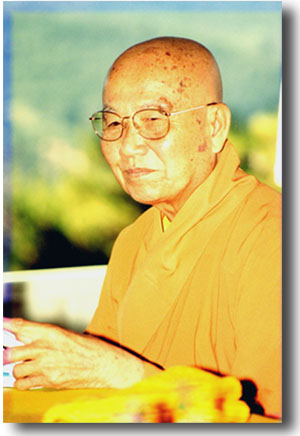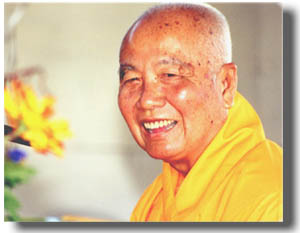|
He was borned and raised in a scholarly family, whose
religion was Cao Dai (a popular religion in Vietnam). At young age, he had revealed
some unique characteristics such as compassion, contemplation, poise, honesty, and
reading interests. As time progressed, his compassion to beings and thought of renunciation
grew stronger. Witnessing human's suffering during wartime, he was awakened and determined
to become a monk. His goal was to find a way to help beings relieve their sufferings.
At the age of 25, he was ordained by Master Thich Thien Hoa at Phat Quang temple after
3 months of Buddhist duties. His Buddhist name was given as "Thich Thanh Tu." Ten
years passed by with much of effort in learning and practicing, he had completed his
basic, intermediate, and high Buddhist education at known Buddhist schools in Vietnam.
Later on, he started teaching at various locations, which include Van Hanh Buddhist
school, Duoc Su Buddhist school, and Hue Nghiem Buddhist College. Over the years of
teaching, he had held several important positions and published a few valuable books.
But his goal would not rest at that point. After 3 years of his servicing as an expression
of gratitude to his Master, he decided to leave on his own to find his "true self"
or his "unlearned knowledge." Knowing the "Pure Land" method would not help him to
accomplish his goal, he decided to proceed meditation. This set of mind had opened
a new chapter for "The Vietnamese Zen
at late 20th century." In 1966, he built Phap Lac meditation center and
lived there to pursuit his practice. During this period of time, he continued his
writings and translations. Two years later, he made a public announcement that he
would practice in seclusion indefinitely. He goal was "if I don't thoroughly discern
the Way, I won't leave the meditation chamber." He had tried different methods such
as contemplations of "Six Marvelous Methods," "Impurity," and even the riddles, etc.
But these gave no results. Though, the failure would never make him quit. At last,
his determination made a harvest as he discerned the concept of "Nothingness." He
then reviewed the Mahayana suttras that discussed about Nothingness and was able to
understand them all. By remembering the phrase "after realization, enlighten others,"
he decided to expose himself to the public to perform Buddhist teachings and other
meaningful tasks.
In December of 1971, the first study program started with 10 students. His principle
of teaching is "learning and practicing concurrently." The reason is he needs to make
sure that our understanding and practicing follow what said in the suttras. This helps
practitioners to evade mistakes that could lead to ailments. His lectures were on
the Buddhist scriptures, discourses, and history as well as the basic meditation methods.
The focus is "aware the false thoughts, but not attach to them." Three years later,
he opened the second program at 3 locations: Linh Quang monastery, Chan Khong monastery,
and Bat Nha monastery. Upto now, he has made many significant accomplishments through
various forms: Writing,
translation, lecturing,
establishing monasteries,
and teaching over a thousand of monks and nuns. Currently, all monasteries (established
by the Master) are learning and practicing the principle of Truc
Lam sect. He always wants to implement what quintessential from Vietnamese
Zen masters that has been forgotten for the past centuries.
Gradually, his dharma teachings have spread all over the world through his lecture
tapes and writings. For several years, he has visited some foreign countries to give
dharma lectures. Numbers of practitioners, scholars, and Buddhist laities have studied
and practiced his Zen methods. His words are quite simple, but profound and excellent,
that people from any background (from a blue color worker to a doctor) could understand.
To make this "transmission of the light" propagate wider to different ethnicities,
some of his books have been
translated into English. Also, the Vietnamese Buddhist Meditation Congregation has
established in 2001 and its headquarter is at Dai Dang monastery in California.
Looking back to his past, we have to praise his intentions, achievements, and merits.
He had done what no one had done which is the task of "Renovating Truc Lam Zen sect"
of Vietnam. With much respect and gratitude, we all try to follow his footsteps to
maintain the existence of Vietnamese Zen. Despite these facts, he is still humble
as he said in the poem "The Wild Sunflowers":
He is just a wild sunflower a wild sunflower that ensconces aside the highways!

 
|

